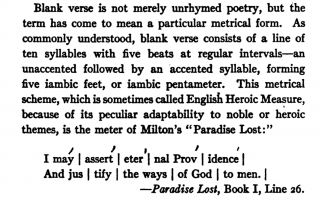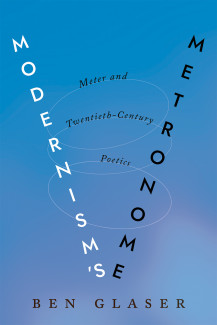
Johns Hopkins UniversityEst. 1876
America’s First Research University
Now Browsing:
Modernism's Metronome: Meter and Twentieth-Century Poetics

Modernism’s Metronome is about poets and readers caught up in meter and unsure about their footing. When I began studying poetry in college, one of the first poems that caught my ear was a metrical tour-de-force—though I didn’t know it then— by the late modern Welsh poet Dylan Thomas. It begins,
The bravura of Thomas’s versification is apparent to me now: the adjacent stresses, echoing Andrew Marvell’s “to a green thought in a green shade”; the winding enjambments driving the thought through the stanza; the dimeter third line that confirms the caesura in the second line as a new, counterpointed pattern for that thought. The meter was already working on me, but my early appreciation wasn’t enough. When I searched the stacks for explications of Thomas’s dense forms and figures, the first pages I encountered told me that this was a Welsh poet, born into the embers of a medieval, bardic, courtly culture with a range of syllabic stanzas. I recall bringing a treatise on Welsh prosody to a reading room and quietly trying to make the “ll” sound as described. The effort didn’t go far. It was a humbling and often to be repeated encounter with my limited knowledge of the phonology and prosody of classical, medieval, and modern languages. It presaged the special difficulty, shared by generations of poets and readers, of tuning in to the polymetrical world of 19th and 20th century poetry. Meanwhile, few of my classes remarked on meter, much less taught me how to turn my pattern recognition (I love to count – I was a math major too) into reasonable claims about poems and about their feelings for prosody.

In graduate school, I discovered both linguistic approaches to metrics and the inspiring example of Yopie Prins’ rhetorical and historical analyses of prosody. What Prins and other historical prosodists like Meredith Martin reveal—and what Modernism’s Metronome seeks to show across early twentieth-century poetry in particular—is that our uneven, eccentric, politicized, and always passionate investments in meter remain the living content of poems even and especially when meter is on the outs. Meter has never been a passive container for poetic language. It has always been an advanced transformation of that language, a way of thinking, an object in its own right. In the anxious maelstrom of modernist redefinitions of poetry, meter is so thoroughly plucked out, ironized, parodied, redeemed, and rejected that it becomes the de-facto medium of even those poems that work hard not to be metrical. My feelings of prosodic inadequacy and hermeneutic confusion were the force that drove my green love of poetry, but also, I discovered, the force that blasts modernity’s sense of form.

I wrote Modernism’s Metronome as an extended effort to account for prosodic forms that demand techniques of scansion which feel vestigial if not arcane. Engaged by scansion, meter brings poetry’s past life to bear on its present and future. Meter channels Thomas’s sense of anachronism, of being driven away from life by the attempt to keep time. The fourth line of each stanza begins “And I am dumb to tell” – and this is exemplary of what I call the metrical “vestige.” Meter as vestige paradoxically expresses the inadequacy of poetic expression while pointing to the complexities and precarity of circulation. It isn’t all negation, though. I hope my readers recognize in the circuits of the metrical vestige a transformed canon and concept of poetry, one capable of discomposing ideologies of gender, race, nation, and class. Amid crisis, poets and readers exhibit joy in the returns of meter, a joy that jars the history of poetry.
Order Modernism's Metronome: Meter and Twentieth-Century Poetics – published on November 3, 2020 – at the following link: https://jhupbooks.press.jhu.edu/title/modernisms-metronome
Ben Glaser is an assistant professor of English at Yale University. He is the author of Modernism's Metronome: Meter and Twentieth-Century Poetics and the coeditor of Critical Rhythm: The Poetics of a Literary Life Form.

The force that through the green fuse drives the flower
Drives my green age; that blasts the roots of trees
Is my destroyer. (l. 1-3)
Drives my green age; that blasts the roots of trees
Is my destroyer. (l. 1-3)
The bravura of Thomas’s versification is apparent to me now: the adjacent stresses, echoing Andrew Marvell’s “to a green thought in a green shade”; the winding enjambments driving the thought through the stanza; the dimeter third line that confirms the caesura in the second line as a new, counterpointed pattern for that thought. The meter was already working on me, but my early appreciation wasn’t enough. When I searched the stacks for explications of Thomas’s dense forms and figures, the first pages I encountered told me that this was a Welsh poet, born into the embers of a medieval, bardic, courtly culture with a range of syllabic stanzas. I recall bringing a treatise on Welsh prosody to a reading room and quietly trying to make the “ll” sound as described. The effort didn’t go far. It was a humbling and often to be repeated encounter with my limited knowledge of the phonology and prosody of classical, medieval, and modern languages. It presaged the special difficulty, shared by generations of poets and readers, of tuning in to the polymetrical world of 19th and 20th century poetry. Meanwhile, few of my classes remarked on meter, much less taught me how to turn my pattern recognition (I love to count – I was a math major too) into reasonable claims about poems and about their feelings for prosody.

In graduate school, I discovered both linguistic approaches to metrics and the inspiring example of Yopie Prins’ rhetorical and historical analyses of prosody. What Prins and other historical prosodists like Meredith Martin reveal—and what Modernism’s Metronome seeks to show across early twentieth-century poetry in particular—is that our uneven, eccentric, politicized, and always passionate investments in meter remain the living content of poems even and especially when meter is on the outs. Meter has never been a passive container for poetic language. It has always been an advanced transformation of that language, a way of thinking, an object in its own right. In the anxious maelstrom of modernist redefinitions of poetry, meter is so thoroughly plucked out, ironized, parodied, redeemed, and rejected that it becomes the de-facto medium of even those poems that work hard not to be metrical. My feelings of prosodic inadequacy and hermeneutic confusion were the force that drove my green love of poetry, but also, I discovered, the force that blasts modernity’s sense of form.

Image: A scansion of Milton’s blank verse, digitized with a reader’s annotations of stress. In Esenwein, Berg, and Roberts, The Art of Versification. Springfield, Mass.: The Home Correspondence School, 1913. https://babel.hathitrust.org/cgi/pt?id=mdp.39015053249754. Accessed via Princeton Prosody Archive, eds. Meredith Martin et al., Center for Digital Humanities, Princeton University, https://prosody.princeton.edu/archive/mdp.39015053249754/
I wrote Modernism’s Metronome as an extended effort to account for prosodic forms that demand techniques of scansion which feel vestigial if not arcane. Engaged by scansion, meter brings poetry’s past life to bear on its present and future. Meter channels Thomas’s sense of anachronism, of being driven away from life by the attempt to keep time. The fourth line of each stanza begins “And I am dumb to tell” – and this is exemplary of what I call the metrical “vestige.” Meter as vestige paradoxically expresses the inadequacy of poetic expression while pointing to the complexities and precarity of circulation. It isn’t all negation, though. I hope my readers recognize in the circuits of the metrical vestige a transformed canon and concept of poetry, one capable of discomposing ideologies of gender, race, nation, and class. Amid crisis, poets and readers exhibit joy in the returns of meter, a joy that jars the history of poetry.
Order Modernism's Metronome: Meter and Twentieth-Century Poetics – published on November 3, 2020 – at the following link: https://jhupbooks.press.jhu.edu/title/modernisms-metronome
Ben Glaser is an assistant professor of English at Yale University. He is the author of Modernism's Metronome: Meter and Twentieth-Century Poetics and the coeditor of Critical Rhythm: The Poetics of a Literary Life Form.

Login to View & Leave Comments
Login to View & Leave Comments


